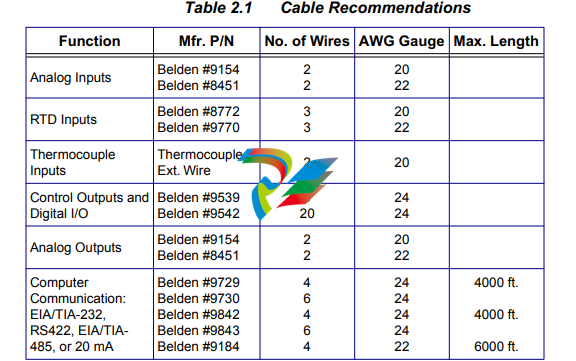
WATLOWMLS300 Series User’s Guide
Never wire bundles of low power Watlow
Anafaze circuits next to bundles of high power ac wiring. Instead, physically separate
high power circuits from the controller. If
possible, install high voltage ac power circuits in a separate panel.
Wiring Recommendations
Keep the following guidelines in mind when selecting wires
and cables:
• Use stranded wire. (Solid wire can be used for fixed
service; it makes intermittent connections when you
move it for maintenance.)
• Use #20 AWG thermocouple extension wire. Larger or
smaller sizes may be difficult to install, may break easily,
or may cause intermittent connections.
• Use shielded wire. (The electrical shield protects the
signals and the MLS300 from electrical noise.) Connect
one end of the input and output wiring shield to earth
ground.
• Use copper wire for all connections other than
thermocouple sensor inputs.
See Table 2.1 on page 33 for cable recommendations.

Noise Suppression
The MLS300’s outputs are typically used to drive solid state
relays. These relays may in turn operate more inductive types
of loads such as electromechanical relays, alarm horns and
motor starters. Such devices may generate electromagnetic
interference (EMI or noise). If the controller is placed close to
sources of EMI, it may not function correctly. Below are some
tips on how to recognize and avoid problems with EMI.
For the AIM or CIM300 earth ground wire, use a large gauge
and keep the length as short as possible. Additional shielding
may be achieved by connecting a chassis ground strap from
the panel to the case of the processor module.
Symptoms of RFI/EMI
If your controller displays the following symptoms, suspect
EMI:
• The controller's display blanks out and then re-energizes
as if power had been turned off for a moment.
• The process variable does not display correctly.
EMI may also damage the digital output circuit—so digital
outputs will not turn on. If the digital output circuit is
damaged, return the controller to Watlow Anafaze for repair.
Avoiding Noise Problems
To avoid RFI/EMI noise problems:
• The MLS300 system includes noise suppression
circuitry. Some of which is only effective when the
components are properly grounded. Be sure the
processor module and AIM (or CIM300) are connected
to earth ground.
• Separate the 120 or 240 Vac power leads from the low
level input and output leads connected to the MLS300
series controller. Don't run the digital I/O or control
output leads in bundles with 120 Vac wires.
• Where possible, use solid-state relays (SSRs) instead of
electromechanical (EM) relays. If you must use EM
relays, try to avoid mounting them in the same panel as
the MLS300 series equipment.
• If you must use EM relays and you must place them in a
panel with MLS300 series equipment, use a 0.01
microfarad capacitor rated at 1000 Vac (or higher) in
series with a 47 Ω, 1/2 watt resistor across the NO
contacts of the relay load. This is known as a snubber
network and can reduce the amount of electrical noise.
• You can use other voltage suppression devices, but they
are not usually required. For instance, you can place a
metal oxide varistor (MOV) rated at 130 Vac for 120 Vac
control circuits across the load, which limits the peak AC
voltage to about 180 Vac (Watlow Anafaze P/N 0802-
0826-0000). You can also place a transorb (back to back
zener diodes) across the digital output, which limits the
digital output voltage.
The above steps will eliminate most EMI/RFI noise problems.
If you have further problems or questions, please contact
Application Engineering
Avoiding Ground Loops
Ground loops occur when current passes from the process
through the controller to ground. This can cause instrument
errors or malfunctions.
A ground loop may follow one of these paths, among others:
• From one sensor to another.
• From a sensor to the communications port.
• From a sensor to the dc power supply.
The best way to avoid ground loops is to minimize
unnecessary connections to ground. Do not connect any of the
following terminals to each other or to earth ground:
• MLS300 PM: TB1, pin 2 (COM)
• MLS300-AIM: TB3, pin 1 to (PWR COM)
• All A COM terminals on the MLS300-AIM or CIM300
• Power Supply: (COM)
• Pin 3 on the RJ connector
Watlow Anafaze strongly recommends that you:
• Isolate outputs through solid state relays, where possible.
• Isolate RTDs or “bridge” type inputs from ground.
• Isolate digital inputs from ground through solid state
relays. If you can't do that, then make sure the digital
input is the only place that one of the above pins connects
to earth ground.
• If you are using EIA/TIA-232 from an un-isolated host,
don't connect any other power common point to earth
ground, or use an optical isolator in the communications
line.
Personal Computers and Ground Loops
Many PC communications ports connect the communications




























































































































